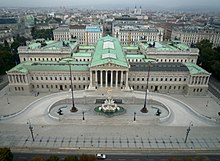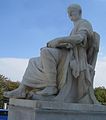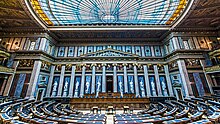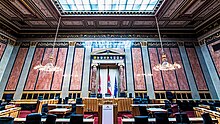Parliament Building (Vienna)
The parliament building in Vienna is the seat of the two chambers of parliament , the National Council and the Federal Council of the Republic of Austria . There are three conference rooms and offices for the members of the parliament in the building. Colloquially, it is usually referred to collectively as "Parliament". It was built from 1874 to 1883 based on a design by Theophil von Hansen for the Imperial Council of the kingdoms and states represented in the Imperial Council , today also called Old Austria ; the architect orientated himself on the ancient Greek architecture . This makes the Reichsratsgebäude an early neoclassical building on the section of the Vienna Ringstrasse with its historic buildings, which has been named Dr.-Karl-Renner-Ring since 1956 .
The parliament building has been undergoing a general renovation since July 13, 2017. Since September 20, 2017, the National Council and the Federal Council have had their alternative quarters in the Vienna Hofburg , with the Great Redoutensaal serving as a meeting room for both chambers, while the offices are housed in temporary external pavilions
1861–1883: Provisional solutions
The Imperial Council called Parliament, as the Empire of Austria and since 1867 in the Austrian part of Austria-Hungary was, was that of Emperor Franz Joseph I. adopted, February Patent founded Constitution of 1861 mentioned and in the December Constitution confirmed the 1867th
Since there was no parliament building in 1861, temporary arrangements urgently had to be created. The provisional building for the House of Representatives of the Reichsrat in Vienna was called somewhat disrespectfully Schmerlingtheater after the Prime Minister Anton von Schmerling . The even more mocking name was "Shack". The other chamber of the Reichsrat, the manor house , used the historic country house at Herrengasse 13 in the old town, the meeting place for the state parliament of Austria under the Enns , as a meeting place .

The temporary solution for the House of Representatives was built by the architect Ferdinand Fellner at Währinger Strasse 2-6 (opposite the construction site of the Votive Church that dominates the square , only one block from Ringstrasse ). Construction of the two-storey transom wall construction began on March 12, 1861. After only six weeks, construction was completed and on April 25, 1861, it was turnkey. In this short time around 500 workers were employed day and night; Night shifts were carried out with torch lighting.
The basic concept of the building with the ramp and the vestibule through which one came into the meeting room already corresponded to the later parliament building. The imperial box could not be missing either. The building was used by the House of Representatives until today's parliament was completed in 1883.
1883: Parliament building on the Ring
The foundation stone for today's parliament building, designed by Theophil von Hansen , was laid on September 2, 1874. The first plenary sessions of the House of Representatives and the Manor House in the new Reichsratsgebäude took place nine years later, on December 4, 1883.
The Greek-born industrialist and art patron Nikolaus Dumba had a decisive influence on the design of the building ; he was appointed in 1885 by Emperor Franz Joseph I as a member of the manor house. The architectural similarity of the parliament building with Hansen's Academy of Athens and the Athens Zappeion, designed by the same architect and also started in 1874, is striking . The construction company in Vienna was Union-Baugesellschaft . For the first time in Vienna, a larger building was not only in the usual linear measure fathoms , but also in the 1871/1872 introduced new unit meters planned and executed.
On November 12, 1918, the power of disposal over the parliament building passed from the Reichsrat (which held its last session on that day) to the parliament of German Austria , at that time the Provisional National Assembly (which met in this building for the first time on that day). In the dictatorship years 1934–1945 the building was not used for parliamentary purposes.
On April 29, 1945, the Soviet city commandant Alexej Blagodatov handed over the parliament building to the Provisional State Government formed on April 27, headed by Karl Renner . (The government had met with Mayor Theodor Körner in the town hall and then, accompanied by Körner and other local politicians, walked through a line of spectators across town hall square and the ring to parliament, which was documented by press photos.)
After the first National Council election of the Second Republic , which took place on November 25, 1945, the building was again taken over by the two parliamentary chambers of the Republic of Austria , the National Council and the Federal Council, established in 1920 .
Political functions
The seat of the Reichsrat had two clearly separated halves, which corresponded to the division of the Reichsrat at that time into a manor house and a house of representatives ; originally two separate buildings were planned. The official name was " kk Reichratsgebäude", but the name "Parlament" was in use from the start.
On November 12, 1918, the last meeting of the House of Representatives of the Imperial and Royal Reichsrat took place here, then on the same day the Provisional National Assembly for German Austria (which had previously met in the Lower Austrian Landhaus) met for the first time in the parliament building and decided that the new state should become republic and Part of Germany is ( First Republic of Austria ). The republic was proclaimed on the parliamentary ramp in front of the crowd waiting on the Ringstrasse . The Constituent National Assembly , which passed the Federal Constitution in 1920 , has met here since March 1919 , and the National Council and Federal Council have met here since November 10, 1920 (1933 / 1934–1945 interrupted) .
After the " self-dissolution of parliament " (a term of Dollfuss dictatorship in the) in March 1933 was held here from May 1934, the Bundestag , the formal legislative body of the Austro-fascist corporate state . 1938–1945 the building was called the "Gauhaus" by the National Socialist regime.
Consequences of war
During the war, the Vienna Parliament building was badly damaged by bombs. On February 7, 1945, a hit destroyed two of the 24 monolithic columns in the central hall , made of red-gray limestone of the Red-Gray-Schnöll type from Adnet (Salzburg) . The two destroyed columns were replaced in 1950 by two new ones, broken from the same quarry. The mansion tract to the south was also badly damaged and the plenary hall of the mansion was almost completely destroyed.
Details about the building
Theophil von Hansen's plans for the exterior design of the parliament building contained noteworthy design elements. Originally, the architect wanted the building to be polychrome on the outside, based on ancient Greek temples . However, the ancient polychromy was very controversial at the time, the prevailing prejudice only allowed the construction in white marble. Color was seen as an "indigenous", if not "barbaric" art form. This influenced the building committee, which rejected the architect's proposal for a multi-colored exterior design. The cost reasons made matters worse. Von Hansen was only allowed to make samples. These are located on the left corner of the facade of the parliament building and on the corner of Reichsratsstraße / Schmerlingplatz and still bear witness to Hansen's concept today.
Front side
The gable of the parliament building still shows symbols of the 17 crown lands of the Austro-Hungarian Empire . At the lower ends of the access ramp there are bronze statues of horse tamers as a symbol of the suppression of passions as a prerequisite for constructive parliamentary cooperation. The four bronze sculptures were designed by the sculptor Josef Lax and cast in the kk art ore foundry in 1897 and 1900.
The building was kept in the Greco-Roman style with neo-Gothic influences. The specialty of the construction lies in the division of the styles. The left, southern wing and the left part of the front were built in Roman style, while the right, northern wing was kept in Greek. The statues on the roof represent famous philosophers, writers and politicians of those same eras. For example, Socrates, Plato or Plutarch can be found on the roof.
There are eight seated statues carved from Lasa marble on the access ramp of the parliament building: on the side of the former manor house statues of the Greek historians Xenophon, Thucydides, Herodotus and Polybius, on the side of the former house of representatives statues of the Roman historians Sallust, Julius Caesar, Titus Livius and Tacitus.
one of the four horse tamers by Josef Lax
Sitting figure of Xenophon by Hugo Haerdtl
Thucydides by Richard Kauffungen (1896)
Polybios by Alois Düll (1899)
Statue of Julius Caesar by Josef Beyer (1900)
Pallas Athene fountain
The Pallas Athene fountain in front of the parliament, designed by Theophil von Hansen, was only built from 1898 to 1902, although the plans had existed since 1870. The figures, a four-meter-high Pallas Athene , allegories of the legislative and executive powers , as well as the four most important rivers in Old Austria - Danube , Inn , Elbe and Moldau - were created by the sculptors Hugo Haerdtl , Josef Tautenhayn and Carl Kundmann . The fact that Pallas Athene, the Greek goddess of wisdom, turned her back on the parliament building led to various jokes and mockery in Austrian vernacular that wisdom was not to be found in parliament.
Meeting room of the House of Representatives or the Federal Assembly
The historic meeting room of the House of Representatives , which offered space for 512 members from Bukovina to Dalmatia , is normally only used today for the meetings of the Federal Assembly on the occasion of the inauguration of the Federal President and for other state acts at which both chambers of parliament are present.
Meeting room of the manor house or the National Council
Today's meeting room of the National Council is located in the south wing of the building in place of the previous meeting room of the manor house, which was destroyed by bombs in 1945 and then completely rebuilt. The conference room, completed in 1956, is a typical example of architecture from the 1950s and is largely unadorned , apart from a federal eagle driven into steel by Rudolf Hoflehner (650 kg, 4 m × 2.8 m). The government bank is located behind the lectern, but it is usually only fully occupied on important occasions such as the government declaration or budget speech. The conference room is technically outdated and not barrier-free and should therefore be completely renovated.
The eagle is being renovated in the course of the renovation. It is too heavy to move to the replacement quarters, the Redoutensaal in the Hofburg. In order to maintain continuity visually for the public, a smaller, much lighter (126 kg including substructure) and divisible copy was made by Vario Shape from Vienna for the Redoutensaal .
Federal Council meeting room
The former anteroom of the manor house has been the meeting room of the Federal Council since 1920 . The interior design of the room has been changed several times over the decades.
Column hall, offices, visitor center
The representative "pillared hall" directly behind the large gates on the ramp is occasionally used for exhibitions and political and social events. In the building there are also various smaller meeting rooms for parliamentary committees, club rooms for the members' clubs (parliamentary groups), work rooms for the President of the National Council and her two deputies, the parliamentary administration , the parliamentary library, the stenographer service, the offices of the State Office for the Protection of the Constitution and Counter-Terrorism in Vienna and a "milk bar" gastronomic operation. The offices of the individual MPs, an achievement of the last few decades, are located in neighboring buildings.
Since October 2005 the Parliament can be entered from the Ringstrasse side through a visitor center, which was newly created as part of a general renovation. The entrance is under the ramp immediately behind the Pallas Athene fountain.
Flagging
The parliament building has a total of five flagpoles, three of which are on the roof of the building and two in front of the building on Ringstrasse.
As a federal building, the parliament building bears the federal official flag on the central mast on the gable of the central building. On the right-hand flagpole on the front gable as seen from the Ringstrasse, the state service flag of the federal state that provides the President of the Federal Council is carried. The flag of the European Union is carried on the left-hand flagpole on the front gable as seen from the Ringstrasse . These three flags are constantly being used.
On the days of the Federal Assembly , the National Council or the Federal Council, the federal official flag is displayed on the two flagpoles in front of the Parliament building, to the left and right of the Pallas-Athene-Fountain . These masts remain empty on days when there are no sessions. Up until 1918, black and yellow flags were used here on meeting days, the imperial colors of Cisleithania .
Conversion (started in 2017, planned until 2022)
An information center in front of the parliament building site provides information about the planning and construction progress.
Decision on a major renovation (2011/2014)
In 2011 the building damage known for years was summarized in a report; the building renovation should cost between 260 and 300 million euros and be carried out from 2014 to 2017 under settlement. In December 2014, the six parliamentary parties agreed on the relocation of parliamentary operations to the redouten halls of the Vienna Hofburg during the renovation work originally planned for 2017 to 2020. The costs for the renovation were estimated at a total of 352.2 million euros, those for the relocation and the alternative quarters at 51.4 million euros, with a tolerance of 20 percent in each case. A new legal resolution would be necessary for any increase in the budget.
On the morning of November 4, 2016, a fire broke out on a cooling tower on the roof of the parliament building, which created a large column of smoke and caused € 60,000 damage. The cause of the fire was determined to be the heating element of the cooling device, which switched on automatically because of the cold and ignited materials and devices next to it that could have come from maintenance work on the roof.
Replacement Redoutensäle quarters and temporary pavilions since 2017
After the general decision was made in 2011 to carry out a major renovation with complete resettlement of the users, it was decided in 2014 to relocate the parliamentary operations to the redouten halls of the Vienna Hofburg and temporary buildings for the period of the renovation .
On June 15, 2017, the ORF published a photo report in cooperation with the Parliament Building Renovation GmbH (PGSG) of the essentially completed alternative quarters: two multi-storey prefabricated pavilions ("Ring" and "Burg") on Heldenplatz and one in the courtyard of the National Library. The first two were wrapped in a dark textile net on which quotations from the Federal Constitution and the UN Charter of Human Rights are printed. The large Redoutensaal was adapted for the plenary; arena steps and a gallery were installed and a small copy of the federal eagle sculpture was installed.
The move began on June 23, 2017 and comprised eight tranches. Office furniture was included, private items such as office plants were not. Furniture that had not been moved was auctioned.
On July 13, 2017, the last meeting of the National Council took place in the parliament building before the renovation. The first National Council meeting took place in the Redoutensaal on September 20, 2017.
In December 2017 it was announced that the renovation of the building would take eight months longer than originally planned. The MPs are to stay in the alternative quarters until March 2021, originally the move back was planned in summer 2020. On February 16, 2018 it was announced that due to higher prices than planned, not all planned construction projects could be implemented. The general renovation of the parliament should be completed in March 2021.
Due to the COVID-19 pandemic and additional projects, such as two tap- proof locations for investigative committees under the historic meeting room, there were delays and higher costs. The move back to the parliament building should take place in the course of 2022.
literature
- Theophil von Hansen: The newly built parliament house in Vienna . In: Journal of the Austrian Association of Engineers and Architects 25, 1873, pp. 319–321 ( digitized version )
- Alfred Wolf: Alsergrund. District of Poets and Thinkers. Vienna 1993
- Alfred Wolf: Alsergrund Chronicle. From Roman times to the end of the monarchy. Vienna 1981
- Matthias Settele: Monument. Viennese city stories. Deuticke, Vienna 1995, ISBN 3-216-30196-6
- Matthias Boeckl: Ancient and Modern. Theophil Hansen's parliament building in Vienna. In: Anna Minta, Bernd Nicolai (ed.): Parliamentary representations. The Bundeshaus in Bern in the context of international parliament buildings and national strategies . Lang, Bern 2014, pp. 139–157.
Web links
- Republic of Austria, parliament, buildings and tours
- Austria Journal: Ideology from 35 tons of marble
- Federal Monuments Office (BDA): Bronze Quadriga on the Vienna Parliament , 2003
- Federal Monuments Office (BDA): The steam chimneys of the Vienna Parliament , November 2006
- Federal Geological Institute : Parliament - Vienna
Individual evidence
- ^ Austrian Parliament : Architecture and history of the parliament building: Building idea , accessed on December 31, 2017
- ^ October diploma and February patent: Constitution with resistance on the server of the Austrian Parliament, accessed on July 22, 2016.
- ↑ 120 years of parliament building . (PDF; 249 kB) Austrian Parliament, p. 16.
- ↑ Nikolaus Dumba ( Memento of the original from December 6, 2014 in the Internet Archive ) Info: The archive link was automatically inserted and not yet checked. Please check the original and archive link according to the instructions and then remove this notice.
- ↑ emporis.com .
- ↑ Law of July 23, 1871, which establishes a new order of weight and measure . Reichsgesetzblatt No. 16/1872.
- ^ Renate Wagner-Rieger: The Vienna Ringstrasse, picture of an epoch. The expansion of the Inner City of Vienna under Emperor Franz Joseph , Volume 8, Part 4, H. Böhlaus Nachf., Vienna 1969, ISBN 3-515-02676-2 , p. 128.
- ↑ derStandard.at - Parliament in the Dictatorship: Research on the Years 1933 to 1945 . APA notification dated June 26, 2015, accessed June 28, 2015.
- ↑ Andreas Rohatsch: Procurement of ashlar for the preservation of historical monuments during the reconstruction period after World War II . In: Austrian Journal for Art and Monument Preservation , Vol. LVIII, Vienna 2004, Issue 3/4, p. 472 ff.
- ↑ Parliament by tram
- ↑ back
- ↑ parliament.gv.at
- ↑ On the Ramp: Historian as a warning to politics . Retrieved July 22, 2016.
- ↑ 120 years of parliament building . (PDF; 249 kB) Austrian Parliament, p. 19
- ↑ http://wien.orf.at/news/stories/2728986/ Parliament renovation : Adler is not moving, orf.at, August 30, 2015, accessed August 30, 2015.
- ↑ Heraldic eagle landed in the replacement quarter orf.at, June 14, 2017, called June 14, 2017.
- ↑ parlament.gv.at House rules for the parliament building (HO06) XII / 64
- ↑ parlament.gv.at House rules for the parliament building (HO06) IV / 26
- ↑ The first substitute bench is: “Today comes the eagle” orf.at June 15, 2017, accessed June 15, 2017.
- ↑ wienerzeitung.at - An extremely expensive project . Article from January 18, 2011, accessed December 4, 2014.
- ↑ derStandard.at - Parliamentary restructuring: National Council will meet in the Hofburg from 2017 . Article dated December 4, 2014, accessed December 4, 2014.
- ↑ Renovation of the parliament building - information on the renovation project . Retrieved December 4, 2014.
- ↑ Parliament: cause of fire clarified orf.at, November 8, 2016, accessed November 8, 2016 ;: Parliament fire : technology plus human error. In: DiePresse.com . November 4, 2016. Retrieved November 6, 2016 .
- ↑ The first substitute bench is: “Today comes the eagle” orf.at June 15, 2017, accessed June 15, 2017.
- ↑ 194th meeting of the National Council. First meeting in the Great Redout Hall
- ↑ orf.at: Parliament renovation takes longer . Article dated December 15, 2017, accessed December 15, 2017.
- ↑ Parliament trims plans for renovation . In: news.ORF.at . February 16, 2018 ( orf.at [accessed February 16, 2018]).
- ↑ Costs for parliament renovation are increasing. In: ORF.at . July 18, 2020, accessed July 19, 2020 .
Coordinates: 48 ° 12 ′ 28.9 ″ N , 16 ° 21 ′ 29.3 ″ E


























